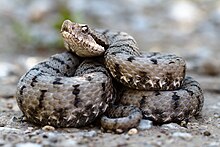European asp
| Vipera aspis | |
|---|---|
 |
|
| Scientific classification | |
| Kingdom: | Animalia |
| Phylum: | Chordata |
| Class: | Reptilia |
| Order: | Squamata |
| Suborder: | Serpentes |
| Family: | Viperidae |
| Genus: | Vipera |
| Species: | V. aspis |
| Binomial name | |
|
Vipera aspis (Linnaeus, 1758) |
|
| Synonyms | |
|
|
Vipera aspis is a venomous viper species found in southwestern Europe. Its common names include asp, asp viper,European asp, and aspic viper,among others. Bites from this species can be more severe than from the European adder, V. berus; not only can they be very painful, but also about 4% of all untreated bites are fatal. The specific epithet, aspis, is a Greek word that means "viper." Five subspecies are currently recognized, including the nominate subspecies described here.
The species grows to an average total length of 60–65 centimetres (24–26 in). Males reach a maximum total length of 85 cm (33 in), females rarely more than 75 cm (30 in). Males, however, are a little slimmer than females. The tail is very short: one-seventh to one-ninth of total body length in females, and one-sixth to one-eighth in males.
The head is broad, triangular and quite distinct from the neck. The tip of the snout is slightly but distinctly upturned. The rostral scale is generally higher than it is wide, touching 2 to 3 scales on the upper side of the snout. Dorsally, the snout is flat with distinct and slightly raised sharp margins. The nasal scale is single (hardly ever divided) and separated from the rostral by a single nasorostral scale. The crown is covered with numerous small and irregular scales of different sizes that are mostly smooth, but sometimes slightly keeled. Frontal and parietal scales are usually not present, but if so, they are small and irregularly shaped, with the frontal separated from the supraoculars by 2 scale rows. The supraocular scales are large and distinct, separated by 4–7 scale rows. There are 10–12 (rarely 8–18) small circumorbital scales below the supraocular. The eye is separated from the supralabials by 2 (rarely 3) scale rows. The vertical diameter of the eye is about the same as the distance between the eye and the mouth. There are 9–13 supralabials. The 4th–5th supralabials (rarely 4th–6th or 5th–6th) are separated from the eye by 2 (rarely 3) rows of small scales, but sometimes there is a single scale between the 4th supralabial and the eye. Generally, the temporal scales are smooth, but sometimes slightly keeled.
...
Wikipedia

